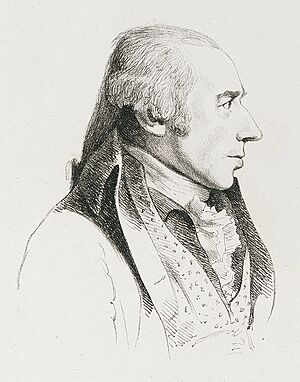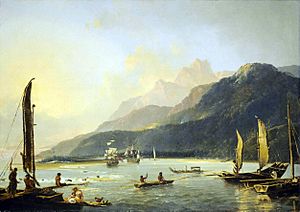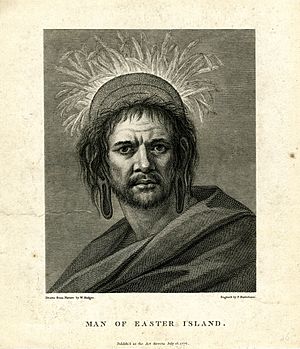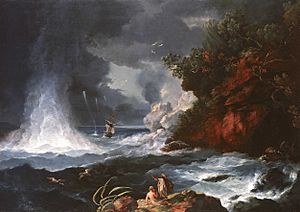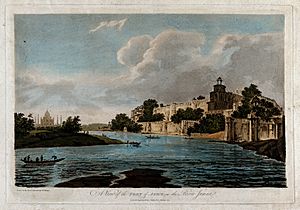William Hodges facts for kids
William Hodges (born October 28, 1744 – died March 6, 1797) was an English painter. He traveled with James Cook on his second big trip around the Pacific Ocean. Hodges is best known for his drawings and paintings of the places he saw on that journey. These places included Table Bay, Tahiti, Easter Island, New Zealand, and even the Antarctic.
Contents
Life and Art of William Hodges
Hodges was born in London in 1744. He learned to paint from famous artists like William Shipley and Richard Wilson. Early in his career, he painted backgrounds for plays.
Journey with Captain Cook
From 1772 to 1775, Hodges joined James Cook's trip to the Pacific. He was the official artist for the journey. Many of his drawings were later turned into engravings for the books about Cook's travels.
After he returned to London, Hodges finished many large oil paintings from his Pacific adventures. He was paid by the British Navy to complete these works. His paintings used strong contrasts of light and shadow. This was a new style for European landscape art at the time. Some art critics thought his paintings looked a bit rough or unfinished because of this.
Hodges also drew many valuable portraits of people from the Pacific islands. He captured scenes of the expedition members during their voyage.
Travels to India and Europe
In 1778, Hodges traveled to India. He was one of the first British landscape painters to visit that country. He stayed there for six years. One of his paintings, "Futtypoor Sicri," is now in Sir John Soane's Museum. In 1794, Hodges published a book about his travels in India, which included his own illustrations.
Later, Hodges traveled across Europe. He even visited St. Petersburg in Russia in 1790.
Later Career and Challenges
In 1794, Hodges held an art show in London. He displayed twenty-five of his paintings. Two large paintings were called The Effects of Peace and The Effects of War. In 1795, Prince Frederick, Duke of York and Albany, visited the show. The Duke did not like the message of Hodges' paintings. He ordered the exhibition to close. This royal disapproval greatly hurt Hodges' career as a painter. Many of his works were later sold, but they did not bring in much money.
Hodges then moved to Devon and became involved with a bank. However, the bank failed during a financial crisis in 1797.
Hodges Knoll in Antarctica is named after William Hodges.
Family Life
William Hodges married three times. His first wife was Martha Bowden Nesbit in 1776. She sadly died within a year.
Hodges returned from India in 1784. He was thought to be a wealthy man. He settled in London and built his own art studio. He brought back a son, James, from India.
In 1784, Hodges married his second wife, Lydia Wright. In 1785, he married for a third time to Ann Mary Carr. She was a talented musician. They had two daughters and three sons together.
Hodges became a member of the Royal Academy in 1789. He continued to show his art there until 1794. After facing money problems, he tried to find support in Russia in 1792, but it was not successful. In 1793, Hodges published a book about his time in India. It was called Travels in India in the Years 1780, 1781, 1782 and 1783. The book included pictures based on his drawings.
In 1794, Hodges held a private art show. It did not attract any buyers, and he had to close it. Feeling very disappointed, Hodges left his painting career. He sold his London home and moved his family to Brixham and Dartmouth in South Devon in 1795. There, he tried to make money by becoming a partner in a small bank.
The bank faced problems because of the ongoing war with France. This, along with other financial issues, caused the bank to fail in March 1797.
Hodges died on March 6, 1797. He was under a lot of stress because of his financial situation and the bank's collapse. He was buried in Brixham.
Even with his money problems, Hodges was liked and respected. Captain Cook admired his sea and landscape paintings from their voyage.
After Hodges died, his wife and children faced hardship. However, many of his friends helped them. Since Hodges was hired by the British Navy for Cook's voyage, all his paintings and drawings from that trip belonged to them. However, he did make copies of some of them.


